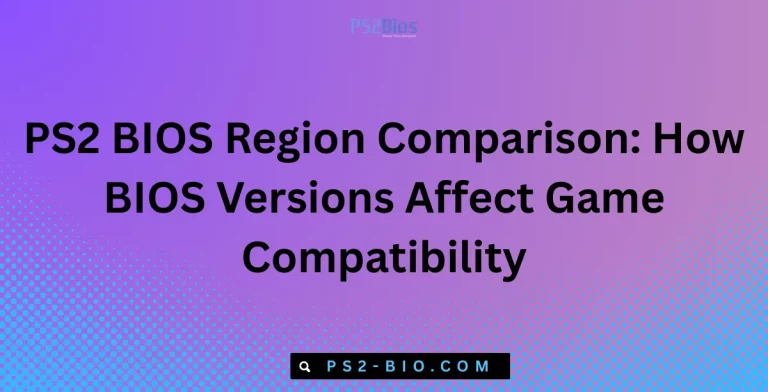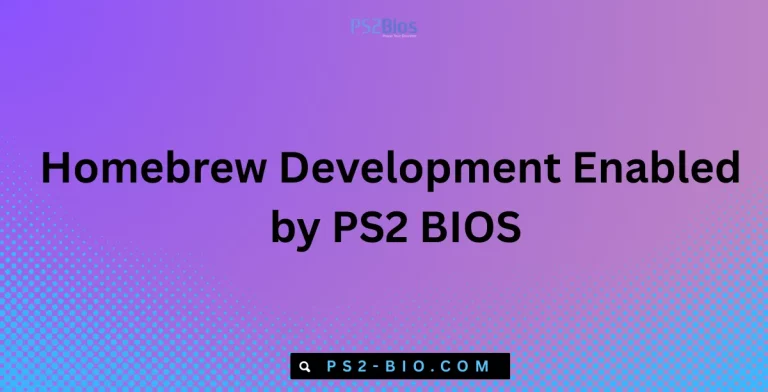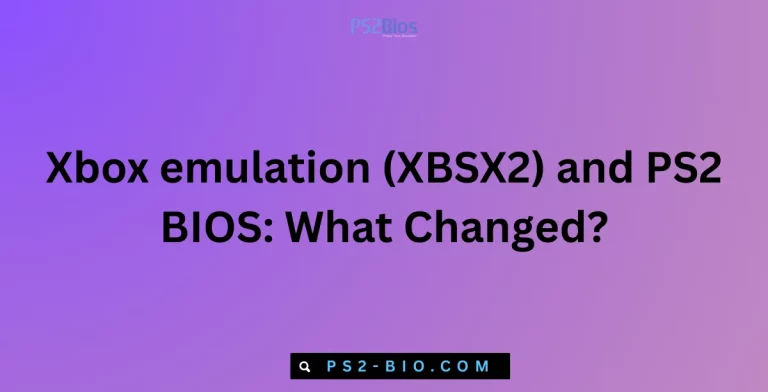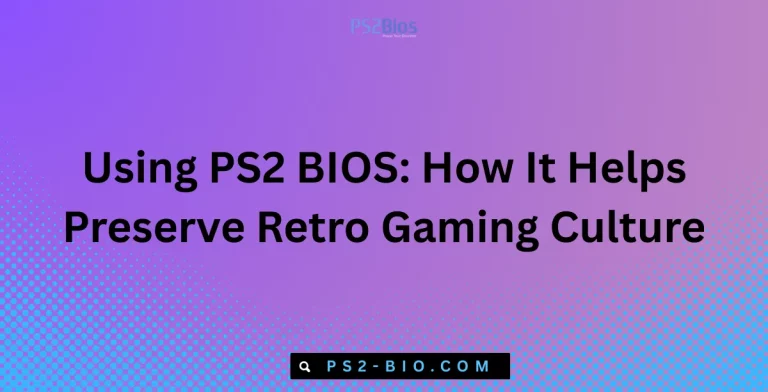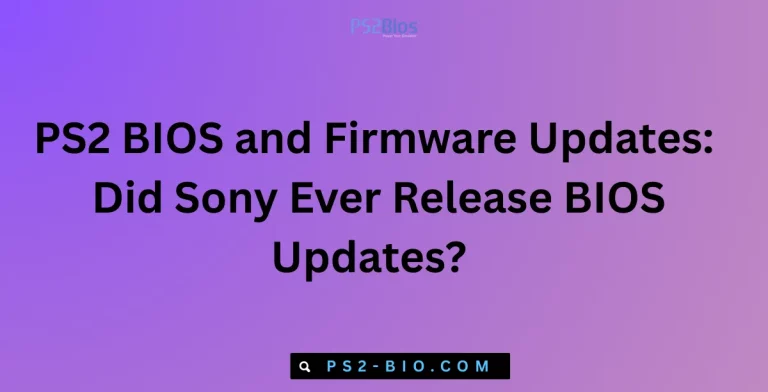Future of PS2 Emulation: Will BIOS Still Be Required?
Do you need a BIOS file to play PlayStation 2 games on emulators in the future? With modern improvements in PCSX2 and emulation technology, the answer isn’t as simple as yes or no. Let’s explore the facts and possibilities ahead.
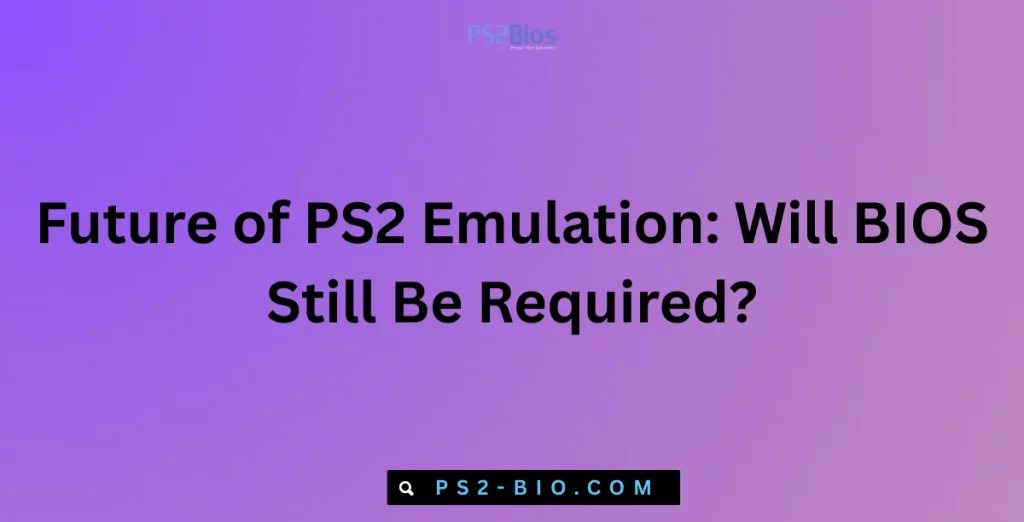
What Is PS2 BIOS and Why Has It Been Essential?
The PS2 BIOS (Basic Input/Output System) is the firmware from an actual PlayStation 2 console. It initializes the hardware, manages input and output, and ensures that the system runs correctly. In emulation, the BIOS allows PCSX2 and other PS2 emulators to replicate the real console environment.
Without the BIOS, games cannot boot in a way that mirrors how they function on Sony’s original hardware. That is why every official PS2 emulator project instructs users to dump the BIOS from their own console. Distributing BIOS files online is illegal because it contains Sony’s copyrighted code.
In short, the PS2 BIOS bridges the gap between original hardware and emulated gameplay. For nearly two decades, it has been a mandatory component of running PS2 games on PC, Linux, and macOS.
How PS2 Emulation Works With BIOS
The BIOS acts as a set of system instructions that the emulator translates for the host machine. When you launch a game, the emulator loads the BIOS first, then uses it to run the PlayStation 2 game image (ISO or disc dump).
The combination of BIOS and emulator ensures that:
- Game compatibility matches the original console.
- Hardware features, such as memory card saves and controller mapping, remain authentic.
- System menus, like the PS2 dashboard, function exactly as on real hardware.
This process is what has allowed PCSX2, launched in 2002, to achieve remarkable compatibility. Today, over 98% of PS2 titles are playable according to official compatibility lists.
The Legal Side: Why BIOS Cannot Be Replaced Easily
One of the main reasons BIOS remains required is legal compliance. Emulation itself is legal in most countries, but distributing proprietary BIOS files is not.
Organizations like the Electronic Frontier Foundation (EFF) recognize emulation as a valid way to preserve gaming history. However, Sony owns the rights to the BIOS. That means any emulator project must avoid including it in their software package.
This legal framework pushes developers to keep BIOS support external instead of building a replacement directly into the emulator.
Will Future Emulators Eliminate BIOS?
The key question is whether the next generation of PS2 emulators can remove the need for BIOS files. Technically, it is possible to re-implement BIOS functions through a method called High-Level Emulation (HLE).
What Is High-Level Emulation?
High-Level Emulation recreates system functions by reprogramming them in the emulator instead of loading original firmware. This has been done successfully in:
- Nintendo 64 emulation, where HLE plugins bypass BIOS-like functions.
- PlayStation 1 emulators, such as DuckStation, which offer partial BIOS replacement options.
If developers fully replicate the PS2 BIOS functions, the emulator could run without requiring users to dump the firmware.
Current Research and Projects Toward BIOS-Free PS2 Emulation
Although no PS2 emulator today has completely replaced BIOS, research continues.
- PCSX2’s Ongoing Development – The PCSX2 team has modernized the emulator with a new Qt interface, Vulkan renderer, and automatic settings. While BIOS is still required, some functions are being replicated internally, reducing dependency.
- OpenBIOS Projects – Hobby developers experiment with reverse-engineering PS2 firmware. These attempts aim to create an open-source BIOS equivalent, similar to projects done for older consoles like the PlayStation 1. However, progress is limited because of the PS2’s complex architecture.
- HLE Advancements – Developers study how to implement IOP (Input Output Processor) and EE (Emotion Engine) calls directly in software. This would reduce reliance on original firmware instructions.
Technical Challenges in Removing BIOS
While BIOS-free emulation sounds promising, several technical challenges make it difficult:
- PS2’s Complexity: The console used custom chips like the Emotion Engine and Graphics Synthesizer. Re-creating their BIOS-level functions requires precise reverse-engineering.
- Accuracy vs. Speed: High-Level Emulation may increase speed but risks breaking compatibility with many games.
- Maintenance: A re-implemented BIOS would need constant updates to match real hardware behaviors.
These challenges explain why, after more than 20 years, no BIOS-free PS2 emulator is fully functional.
Why BIOS May Still Be Required in the Near Future
Based on the current state of emulation:
- Accuracy: The real BIOS ensures near-perfect reproduction of PS2 game behavior.
- Compatibility: Over 3,800 PS2 titles exist. BIOS maintains consistent performance across this huge library.
- Legal Caution: Developers avoid building a BIOS replacement that risks legal issues.
For these reasons, BIOS files are likely to remain a requirement for at least the next few years.
The Role of BIOS in Game Preservation
Beyond gaming convenience, the PS2 BIOS plays a vital role in digital preservation. With more than 155 million PlayStation 2 units sold worldwide, it remains the best-selling console in history.
Without BIOS, many features like memory card management, regional system menus, and hardware startup sequences would be lost. Emulators aim not only to play games but also to preserve the authentic experience of using a PS2.
Future Possibilities: What Could Change
Even though BIOS is still required today, the future may bring change.
- Improved HLE: With advances in reverse-engineering, developers might build a BIOS replacement that achieves high compatibility.
- Legal Reform: If copyright law evolves to allow firmware preservation, projects could safely integrate BIOS-like functions.
- AI-Powered Emulation: Modern AI tools could analyze and replicate PS2 firmware instructions, creating accurate BIOS substitutes faster.
These possibilities mean that while BIOS is essential now, its role may diminish over the next decade.
Comparing PS2 BIOS With Other Consoles
Looking at other systems helps understand what might happen with PS2:
- NES and SNES: Do not require BIOS; emulators replicate functions easily.
- PlayStation 1: Some emulators offer HLE BIOS, but accuracy improves when using real BIOS.
- Dreamcast: Uses a BIOS, though some emulators integrate partial replacements.
- PlayStation 3 and beyond: Firmware complexity makes BIOS extraction and emulation essential.
This trend shows that as consoles become more advanced, BIOS requirements remain strong.
User FAQs About PS2 BIOS and Emulation
1. Is it legal to download PS2 BIOS online?
No. The only legal way is to dump the BIOS from your own PS2 console.
2. Can PCSX2 run without BIOS?
Currently, no. PCSX2 and other PS2 emulators require the original BIOS file.
3. Will BIOS-free PS2 emulators exist in the future?
Possibly, but only if HLE implementations reach full accuracy.
4. Why doesn’t PCSX2 include BIOS by default?
Because BIOS is copyrighted by Sony, distributing it would be illegal.
Conclusion
The future of PS2 emulation depends on balancing technical progress with legal realities. For now, the BIOS remains essential for running PlayStation 2 games on emulators like PCSX2. It ensures accuracy, compatibility, and preservation of the console’s original experience.
While research into HLE and open-source BIOS replacements continues, the complexity of PS2 hardware makes a full replacement unlikely in the short term. Still, as technology evolves, the day may come when emulators no longer rely on original BIOS files—offering a more accessible way to preserve the legacy of PlayStation 2 gaming.

